A personal reminiscence by Alan Wrigley
|
My memory has been getting steadily worse over the years, but I surprised even myself the other day when I realised I had totally overlooked an important landmark. This year, 2005, marks my twentieth year in business with Acorn. Yes, I know, Acorn no longer exists, but the box on the floor that powers much of my business clearly says Acorn on the case, just as its predecessor did twenty years ago.
It all started with the BBC Micro, of course. I hankered after one for a long time but couldn't justify the expense. Eventually I bought a Dragon 32 at half the price of the BBC. I justified the purchase to my sceptical wife by claiming it would help me to catalogue my photographic collection and turn it into a source of income, but in truth I was fascinated by the possibilities of programming, which I had never done before. I finally started the photo cataloguing project fourteen years later...
|

|
The author enjoying a break from his computers
Photo copyright © Jane Willetts 2004
|
Having cut my teeth on the Dragon and proved my programming capabilities by writing and launching two games (which sold five copies each if I remember correctly, but did get an excellent review in the Dragon users' magazine), the debate over expense was won and I staggered home with a BBC B under my arm. The series of programmes shown on BBC TV (Making the Most of the Micro and Micro Live) had served to convince me that my Dragon was a mere toy and I needed a real computer.
View from my office in Cologne before I'd ever heard of Acorn!
Photo copyright © Alan Wrigley 1982
|
|

|
|
In January 1985 we took the plunge and launched a new business with the help of a grant from the Enterprise Allowance scheme. Our grand idea was to provide much-needed computer-based services for local businesses in the area where I then lived, the Calder Valley in West Yorkshire. We planned to offer word-processing, book-keeping, spreadsheet compilation, business reports etc.; anything that could be done more efficiently with a computer. Remember that those were the days when most businesses did not have a computer, and all these tasks were done manually. I invested in the most up-to-date business-oriented equipment (a Z80 second processor running CP/M), called the company Calderdata, bought two very expensive printers (a daisywheel and a colour dot-matrix that cost a small fortune each), and sat at the keyboard in readiness while my wife went to sell the idea to small businesses in the area. The general response from the local community was along the lines of, "By 'eck, we've been doing it this way for years, why would we want owt else?"
|
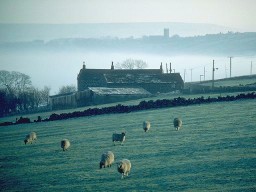
|
View from Calderdata's office in Luddenden Foot
Photo copyright © Alan Wrigley 1985
|
As often happens, salvation came out of the blue. Because formatting and printing labels was a pain in those days, I wrote my own software to do it. I suddenly realised that this might be marketable in its own right, so I polished it up and launched it as LabelMaster, eventually changing the company name to Labelwise. It did indeed prove popular, as it filled a gap in the market, and during the next few years it gained over a thousand appreciative customers. When RISC OS arrived I started to write a top-of-the-range WYSIWYG label designer and address book called Archetype to replace LabelMaster, but once DTP took off there was less need for such a product and it never got finished.
Just round the corner from Labelwise's office in Slaithwaite
Photo copyright © Alan Wrigley 1989
|
|
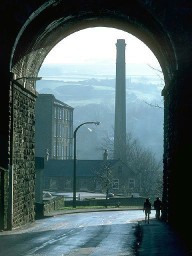
|
During this period (probably around 1986) I spotted an item in one of the magazines announcing the formation of an Acorn Business Users Group (ABUG) and called the number, as I thought it might be a useful organisation to join. It turned out that it was, at that point, little more than the brainchild of one person by the name of Jim Doyle, and by phoning him I had effectively become a founder member and co-opted myself onto the committee! Jim was fired with enthusiasm and ideas, and a core group of half a dozen of us, spurred on by Jim, worked hard over the next few months to build the group; I even got my local paper, the Halifax Courier, to write an article about my involvement, such was the general high regard for the BBC computer at that time. But we hit a problem: most people running their own businesses are just too busy to get involved in user groups, and we struggled to gain members. Then, just as suddenly as he had sprung to life, Jim disappeared into the night and ABUG deflated as quickly as he had inflated it in the first place.
|
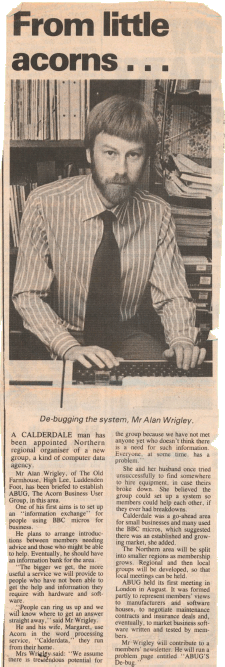
|
Press cutting from the Halifax Courier in the days when the BBC Micro ruled the world
|
|
In 1989 I answered an advert for Technical Editor at Beebug and was offered the position. For the next few years, software development mostly took second place as I spent my time immersed in the world of Acorn-related journalism, first as Technical Editor, then as a freelance, and finally as Editor of RISC User before handing over the reins to Richard Hallas. During this period I did engage in some software projects, most of which were simple affairs destined for RISC User magazine discs. One of these, however, did appear to have more potential and was promoted from magazine disc to commercial product. This was Vigil, a multi-tasking debugger that I launched in 1993 under the Rheingold Enterprises label. Debugging applications on the desktop had always been a tricky business, and Vigil simplified it by enabling developers to see what was happening inside their application while it was running in real-time in a multi-tasking environment. The product had some excellent reviews and sold well for a short while, but it was really too late into the market, since by then the number of users actively developing their own programs on RISC OS had slumped from its peak a few years earlier.
|
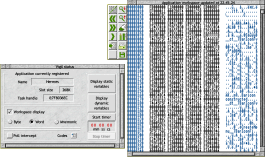
|
Vigil debugging Hermes
|
View from Rheingold Enterprises' office in Warrington
Photo copyright © Alan Wrigley 1993
|
|
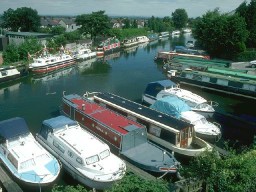
|
|
Two other smaller projects from this period were TextAid, also published by Rheingold, and PolyGlot, published by Beebug. Of more significance was my involvement in producing a book, Wimp Programming for All. This started out as a project to collate Lee Calcraft's excellent series of RISC User articles, Mastering the Wimp, into book form. I ended up writing a lot of additional material so, in the end, the content was shared about 50-50 between Lee and myself. In order to prove the worth of the platform for DTP, the book was produced entirely in Ovation.
|
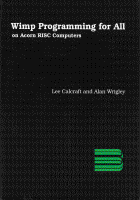
|
The front cover of Wimp Programming for All, published by Beebug
|
While wearing my journalist's hat I learned much about what went on inside Acorn and made many interesting contacts, one of which was to have a profound effect on my career. Over lunch at an Acorn press briefing in Cambridge I was chatting to Malcolm Bird (who at the time was Director of Acorn's Online Media division) and mentioned that I really wanted to get back into software development. A couple of weeks later I received an email from him, asking if I fancied a few weeks in San Francisco!
The Golden Gate Bridge, San Francisco
Photo copyright © Alan Wrigley 1996
|
|

|
|
In fact, I ended up spending four months in Silicon Valley that year (1996), helping Oracle to port some of their software to Acorn's set-top box. As a result of contacts I made, I was invited back to California for a large part of the following year by Network Computer Inc (NCI, later renamed Liberate) to develop a TV Guide (or EPG, which stands for Electronic Programme Guide) for the Acorn-based network computer project. This was followed by contract work for NetChannel, which was providing the ISP service for network computer users; for Acorn itself in Cambridge; and for iMagicTV in New Brunswick, Canada, which was also using Acorn-powered technology for interactive services.
|
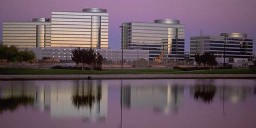
|
The Oracle headquarters in Redwood Shores, California
Photo copyright © Alan Wrigley 1996
|
|
A version of the TV Guide produced for NCI's network computer
|
|
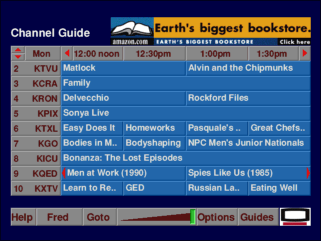
|
At NCI and NetChannel I was working for Steven Ericsson Zenith, a maverick technologist and larger-than-life character who once wrote software for the BBC Micro as Haiku Software, but latterly spent his time ruffling feathers in Silicon Valley. When he founded his own company, The Kiss Principle, in 1999 he invited me to be his chief developer and I spent two years on the dark side for the first time in my life. Our project, funded by a million-dollar contract from Microsoft, was to develop an interactive chat client for the Microsoft TV platform, running on a variant of Windows CE.
|
Screenshots from The Kiss Principle's Chat on Television
|
|
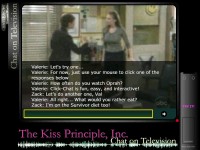
|
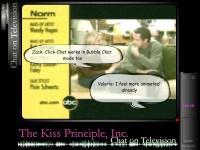
|
|
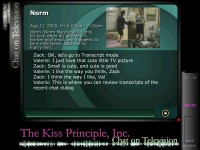
|
It was a thoroughly fascinating and innovative project of which I have fond memories, but even as I worked for Microsoft I was unknowingly furthering the cause of RISC OS software. When the project, and the company, ground to a halt in 2001 as the dotcom bubble burst, I approached R-Comp on my return to the UK and suggested that they might like to make use of my experience with chat clients to provide a professional IRC and MSN client for RISC OS. The result was Grapevine, launched at Wakefield in 2002 and still going strong, having had numerous enhancements including the addition of an ICQ client.
|
The Grapevine logo (right), Grapevine in IRC mode (below) and Grapevine in MSN mode (below right)
|
|

|
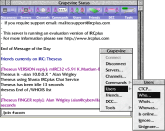
|
|
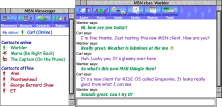
|
|
The success of Grapevine encouraged R-Comp to invest in further projects, including UniPrint, which allows RISC OS users to print via a PC across a network without needing a special driver for the printer, and, more recently, Hermes, which has been designed as a comprehensive email transport solution, incorporating many advanced features that have previously been unavailable on RISC OS. Watch out for a brand new version of Hermes with exciting new features at Wakefield 2005!
|
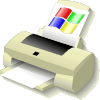
|

|
UniPrint and Hermes logos
|
|
While all this directly Acorn-related activity was going on, I was also putting my trusty Risc PC to use in other areas, too. Having been an enthusiastic user of the Micronet online service run by Prestel in the 1980s, I needed little persuasion to get involved in the Internet. In 1994 I had the idea of creating a Web site specifically for Acorn users and, because Acorn had called its stand at some exhibitions The Acorn Village, I decided The Acorn Cybervillage would be a great name for an online service. I asked Acorn if it was happy for me to use the name in this way, and it was deemed acceptable. Just as I was about to start work on the site I discovered that Stuart Halliday was also thinking of a similar site for Acorn users, so I discussed it with him and we decided to launch the UK Cybervillage (http://www.cybervillage.co.uk/) jointly, with Stuart taking responsibility for the Acorn Cybervillage, leaving me free to develop other non-Acorn sites under the same umbrella. Sadly, these other sites never got beyond the early stages as a result of my frequent disappearances to the USA. Most of the non-RISC OS part of the site you can see today has been untouched for several years.
|
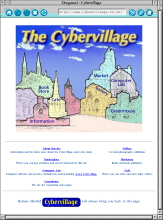
|
The UK Cybervillage
|
I mentioned at the beginning that my original reason for buying a computer was to catalogue my photographic collection. This had to wait until the advent of greater storage capacity and powerful software, but eventually the combination of Risc PC, Photodesk and DataPower made the project viable. I use Photodesk for all my image manipulation and cleaning, and DataPower for all my local database work. The 'grand project' (probably my magnum opus) is to put all worthwhile images from my collection of around 30,000 transparencies online into a searchable database. The first fruits of this can be seen at http://photos.alanwrigley.com/, but there's a very long way to go yet!
DataPower also came to the fore in 1999 when my wife and I took over Vegetarian Matchmakers, the UK's premier dating service for vegetarians. From the outset I wanted to automate as much of it as possible so that it could run like clockwork under the watchful eye of a very non-techie wife while I was away in America, so I made heavy use of DataPower scripts to automate everything from compiling lists of members' profiles to generating renewal notices. Among the innovative features I developed was two-way communication between DataPower and the MySQL database on the Web site. Any alterations locally are automatically emailed to the site, where a script updates the SQL database, and any alterations online are similarly emailed back to the local machine with an attached script that updates the local database. It has all worked perfectly for six years and, thanks to Virtual Risc PC, the system is future-proofed if ever my old Acorn kit gives up the ghost.
Like most RISC OS users these days, I bow to the inevitable and use a Windows PC as well. Contrary to many of them, I actually like Windows XP from a user's point of view (though the security and world-domination aspects leave me concerned!). I'm unlikely to find an acceptable replacement for Photodesk, DataPower and Ovation Pro for a long while, so I will continue to use RISC OS for the foreseeable future. I know that two of those are now available for Windows, but what's the point in spending more money when I'm perfectly satisfied with what I have? Also, I would find it very hard to duplicate DataPower's interaction with the system (e.g. for sending emails) on Windows.
View from Alan Wrigley Dotcom's office in Market Lavington
Photo copyright © Alan Wrigley 2004
|
|

|
These are my twenty years in business with Acorn. During that time my businesses have run on a BBC B, BBC Master, A310, A540, several Risc PCs and Virtual Risc PC. While it would be fanciful to think it could last for another twenty years, I have no doubt that RISC OS will be on my desktop for some time to come.
You can find Alan Wrigley on the web at http://www.alanwrigley.com/.



















